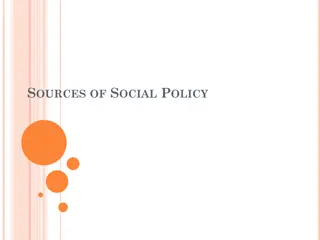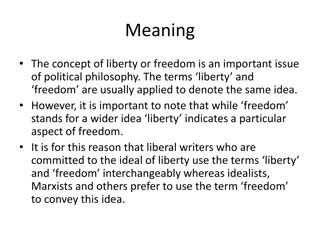Rawls' Theory of Justice: Balancing Liberty and Equality
John Rawls, a prominent American philosopher, introduced his theory of justice in his influential book "A Theory of Justice." He emphasized the importance of distributive justice and rational choices in shaping fair social arrangements. Rawls believed in a principle where rational agents would select just principles of justice, balancing individual liberty and equality in society.
Download Presentation

Please find below an Image/Link to download the presentation.
The content on the website is provided AS IS for your information and personal use only. It may not be sold, licensed, or shared on other websites without obtaining consent from the author. Download presentation by click this link. If you encounter any issues during the download, it is possible that the publisher has removed the file from their server.
E N D
Presentation Transcript
Philosophy 219 Justice as Fairness/Justice as Holdings: Rawls/Nozick
Libert, galit, Fraternit This is the national slogan of France, coined during the French revolution. It nicely embodies the ideals of that revolution, as well as those of our own, at least as they are articulated in The Federalist Papers. I invoke them at the start of this week s discussion as a suggestive question: Where is the brotherhood?
John Rawls (1921-2002) Rawls was one of the most prominent American philosophers of the 20th century. Working primarily in the areas of political philosophy and ethical theory, Rawls was one of the foremost defenders of Political Liberalism: the idea that government should be neutral with regard to the question of what constitutes a good life.
A Theory of Justice (1971) This was the book that made Rawls famous. It was an attempt to at a project very similar to that of The Federalist Papers, namely, to argue for a principled reconciliation of liberty and equality. Rawls s strategy was to address the question of distributive justice (how to parcel out the burdens and benefits of our social/political existence) with the help of a thought experiment designed to engage our instincts about fairness, within which parties would hypothetically choose mutually acceptable principles of justice. Rawls s thesis was that his principle of justice was the one that rational agents would choose.
Rawlss Starting Point Rawls starts with a minimal definition of human society: an association organized by a shared understanding of justice the aim of which is to advance the good of the members. As Rawls immediately acknowledges, there is a fundamental tension in such a society. On the one hand, individual members have good reason to pursue the good of society; after all, most of the goods we desire we cannot secure on our own. On the other hand, people are naturally interested in maximizing their own good, putting them in inevitable conflict with those around them.
Distributive Justice A question which immediately arises is, how do we deal with these (potentially frequently) competing views of the good. This is a question of distributive justice (Jd), which Rawls defines as "a set of principles for choosing between the social arrangements which determine th[e] division [of goods].
Contract Theory Rawls considers a number of ethical and political accounts of Jdbut ultimately advocates a version of contract theory. Rawls belongs, then, to a familiar tradition. He is a descendent of Locke and Rousseau. Most importantly, like traditional contract theory, the force of the contract Rawls introduces comes from the assumption that it is agreed to by free, rational creatures.
The Original Position Rawls is definitely not just repeating the tradition he inherits. Rather than place this agreement in some fictional state of nature, a supposition which may do nothing more than institutionalize a particular historical conception of the individual, Rawls locates his agreement behind what he calls the "veil of ignorance." Behind the veil, Rawls argues, the rational decision procedure would include assuming that you will be disadvantageously placed. As a result, the contract would embody structural principles to insure that any distribution of goods would benefit the fortunate and the unfortunate equally.
Two Principles of Justice Parties in the original position, behind the veil of ignorance, rationally evaluating their potential exposure to inequalities of distribution, would agree, Rawls argues, to a contract that embodies two substantive principles of justice: Equality Principle: every one engaged in or affected by an institution has an equal right to the most complete liberty compatible with the liberty of all; Difference Principle: The only non-arbitrary was to assign benefits and burdens to members of a society is to assign them in such a way as to benefit everyone. These two principles make up what Rawls calls Justice as Fairness.
Politics as Fairness Rawls goes on to develop an account of the structural principles of a democracy consistent with this theory. Such a government would have four branches: Allocation: maintain economic competition and efficiency; Stabilization: maximize employment and protect free choice of occupation; Transfer: respond to social need; Distribution: preserve just distribution of wealth by limiting excessive accumulation of wealth from generation to generation and taxation.
Robert Nozick (1938-2002) Nozick was a lifelong colleague of Rawls at Harvard. He established his reputation by writing Anarchy, State and Utopia, a response to Rawls s A Theory of Justice. With this book, Nozick became a prominent proponent of Libertarianism: a range of political philosophies which share a commitment to individual liberty at the expense of civil society.
Anarchy, State and Utopia Nozick s argument in ASU explicitly appeals to Locke s Treatise, particularly its reliance on the claim that a right to property is a natural or basic one. In it he argues that a distribution of goods is just if brought about by free exchange among consenting adults and from a just starting position, even if large inequalities subsequently emerge from the process.
Political Minimalism In ASU, Nozick puts his ideological cards on the table. He's a political minimalist: only the minimal state can be justified. In this context, Jdhas a much more restricted sense than in Rawls's theory. What is fundamental are holdings (property) and transfers of holdings. Distribution is defined relative to them.
Entitlement Theory Given his starting point, it should not be surprising that Nozick has a much different account of Jdthan Rawls. Nozick's term for the theory of justice that is operative from the assumption that holdings are fundamental is Entitlement Theory (496c1-2). ET has two main elements: Justice in acquisition; Justice in transfer. Jdis derived from this theory, A distribution is just if it arises from another just distribution by legitimate means (c2), in other words by ET.
What about History? One obvious objection to this view points out that a claim of "entitlement" may have questionable historical ramifications (reparations for slavery). In this context, Nozick identifies a third element of ET: Justice in Rectification (497c2). Nozick turns this weakness into a strength, noting that in contrast to utilitarianism, which focuses on the present, the entitlement theory is historically sensitive.
Focusing on End-Results The rest of the selection focuses on what Nozick calls end-result theories, theories of Jdwhich evaluate distributive schemes on consequentialist grounds. His objection to these theories is that they would require constant interference. Individual qualities (skills, talents, ambitions) would necessarily create imbalances and thus would require constant readjustments to the political structure.























